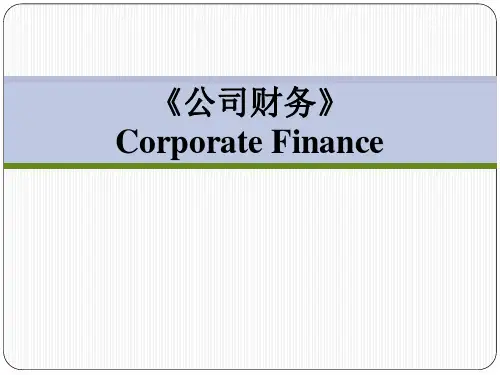公司理财chap009
- 格式:ppt
- 大小:1.02 MB
- 文档页数:39

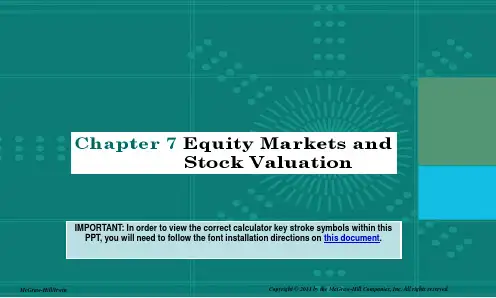
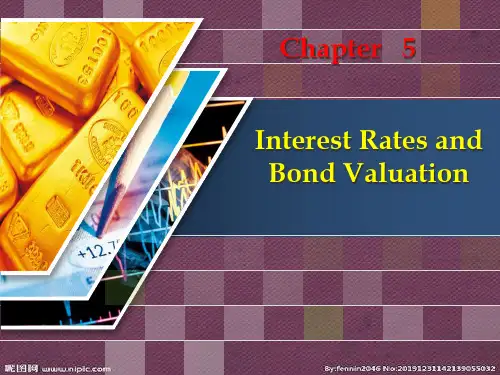

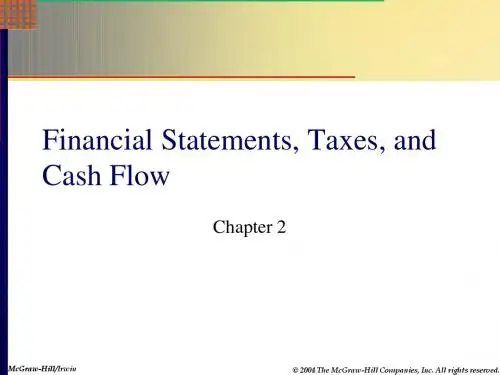
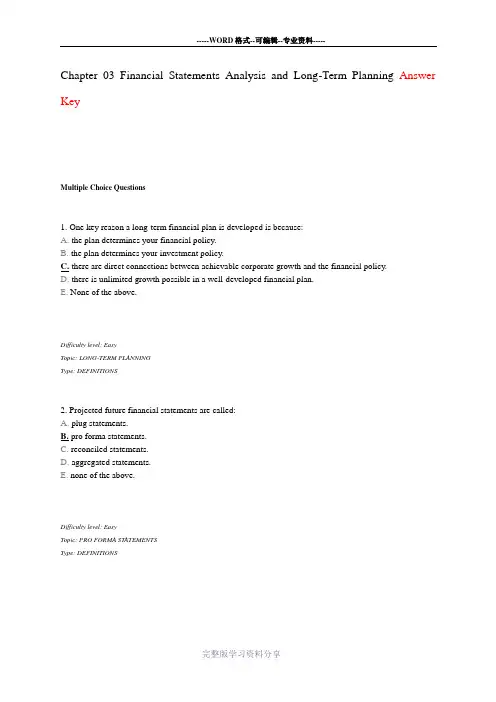
Chapter 03 Financial Statements Analysis and Long-Term Planning Answer KeyMultiple Choice Questions1. One key reason a long-term financial plan is developed is because:A. the plan determines your financial policy.B. the plan determines your investment policy.C. there are direct connections between achievable corporate growth and the financial policy.D. there is unlimited growth possible in a well-developed financial plan.E. None of the above.Difficulty level: EasyTopic: LONG-TERM PLANNINGType: DEFINITIONS2. Projected future financial statements are called:A. plug statements.B. pro forma statements.C. reconciled statements.D. aggregated statements.E. none of the above.Difficulty level: EasyTopic: PRO FORMA STATEMENTSType: DEFINITIONS3. The percentage of sales method:A. requires that all accounts grow at the same rate.B. separates accounts that vary with sales and those that do not vary with sales.C. allows the analyst to calculate how much financing the firm will need to support the predicted sales level.D. Both A and B.E. Both B and C.Difficulty level: MediumTopic: PERCENTAGE OF SALESType: DEFINITIONS4. A _____ standardizes items on the income statement and balance sheet as a percentage of total sales and total assets, respectively.A. tax reconciliation statementB. statement of standardizationC. statement of cash flowsD. common-base year statementE. common-size statementDifficulty level: EasyTopic: COMMON-SIZE STATEMENTSType: DEFINITIONS5. Relationships determined from a firm's financial information and used for comparison purposes are known as:A. financial ratios.B. comparison statements.C. dimensional analysis.D. scenario analysis.E. solvency analysis.Difficulty level: EasyTopic: FINANCIAL RATIOSType: DEFINITIONS6. Financial ratios that measure a firm's ability to pay its bills over the short run without undue stress are known as _____ ratios.A. asset managementB. long-term solvencyC. short-term solvencyD. profitabilityE. market valueDifficulty level: EasyTopic: SHORT-TERM SOLVENCY RATIOSType: DEFINITIONS7. The current ratio is measured as:A. current assets minus current liabilities.B. current assets divided by current liabilities.C. current liabilities minus inventory, divided by current assets.D. cash on hand divided by current liabilities.E. current liabilities divided by current assets.Difficulty level: EasyTopic: CURRENT RATIOType: DEFINITIONS8. The quick ratio is measured as:A. current assets divided by current liabilities.B. cash on hand plus current liabilities, divided by current assets.C. current liabilities divided by current assets, plus inventory.D. current assets minus inventory, divided by current liabilities.E. current assets minus inventory minus current liabilities.Difficulty level: EasyTopic: QUICK RATIOType: DEFINITIONS9. The cash ratio is measured as:A. current assets divided by current liabilities.B. current assets minus cash on hand, divided by current liabilities.C. current liabilities plus current assets, divided by cash on hand.D. cash on hand plus inventory, divided by current liabilities.E. cash on hand divided by current liabilities.Difficulty level: MediumTopic: CASH RATIOType: DEFINITIONS10. Ratios that measure a firm's financial leverage are known as _____ ratios.A. asset managementB. long-term solvencyC. short-term solvencyD. profitabilityE. market valueDifficulty level: EasyTopic: LONG-TERM SOLVENCY RATIOSType: DEFINITIONS11. The financial ratio measured as total assets minus total equity, divided by total assets, is the:A. total debt ratio.B. equity multiplier.C. debt-equity ratio.D. current ratio.E. times interest earned ratio.Difficulty level: EasyTopic: TOTAL DEBT RATIOType: DEFINITIONS12. The debt-equity ratio is measured as total:A. equity minus total debt.B. equity divided by total debt.C. debt divided by total equity.D. debt plus total equity.E. debt minus total assets, divided by total equity.Difficulty level: EasyTopic: DEBT-EQUITY RATIOType: DEFINITIONS13. The equity multiplier ratio is measured as total:A. equity divided by total assets.B. equity plus total debt.C. assets minus total equity, divided by total assets.D. assets plus total equity, divided by total debt.E. assets divided by total equity.Difficulty level: MediumTopic: EQUITY MULTIPLIERType: DEFINITIONS14. The financial ratio measured as earnings before interest and taxes, divided by interest expense is the:A. cash coverage ratio.B. debt-equity ratio.C. times interest earned ratio.D. gross margin.E. total debt ratio.Difficulty level: MediumTopic: TIMES INTEREST EARNED RATIOType: DEFINITIONS15. The financial ratio measured as earnings before interest and taxes, plus depreciation, divided by interest expense, is the:A. cash coverage ratio.B. debt-equity ratio.C. times interest earned ratio.D. gross margin.E. total debt ratio.Difficulty level: MediumTopic: CASH COVERAGE RATIOType: DEFINITIONS16. Ratios that measure how efficiently a firm uses its assets to generate sales are known as _____ ratios.A. asset managementB. long-term solvencyC. short-term solvencyD. profitabilityE. market valueDifficulty level: EasyTopic: ASSET MANAGEMENT RATIOSType: DEFINITIONS17. The inventory turnover ratio is measured as:A. total sales minus inventory.B. inventory times total sales.C. cost of goods sold divided by inventory.D. inventory times cost of goods sold.E. inventory plus cost of goods sold.Difficulty level: MediumTopic: INVENTORY TURNOVERType: DEFINITIONS18. The financial ratio days' sales in inventory is measured as:A. inventory turnover plus 365 days.B. inventory times 365 days.C. inventory plus cost of goods sold, divided by 365 days.D. 365 days divided by the inventory.E. 365 days divided by the inventory turnover.Difficulty level: MediumTopic: DAYS' SALES IN INVENTORYType: DEFINITIONS19. The receivables turnover ratio is measured as:A. sales plus accounts receivable.B. sales divided by accounts receivable.C. sales minus accounts receivable, divided by sales.D. accounts receivable times sales.E. accounts receivable divided by sales.Difficulty level: MediumTopic: RECEIVABLES TURNOVERType: DEFINITIONS20. The financial ratio days' sales in receivables is measured as:A. receivables turnover plus 365 days.B. accounts receivable times 365 days.C. accounts receivable plus sales, divided by 365 days.D. 365 days divided by the receivables turnover.E. 365 days divided by the accounts receivable.Difficulty level: MediumTopic: DAYS' SALES IN RECEIVABLESType: DEFINITIONS21. The total asset turnover ratio is measured as:A. sales minus total assets.B. sales divided by total assets.C. sales times total assets.D. total assets divided by sales.E. total assets plus sales.Difficulty level: EasyTopic: TOTAL ASSET TURNOVERType: DEFINITIONS22. Ratios that measure how efficiently a firm's management uses its assets and equity to generate bottom line net income are known as _____ ratios.A. asset managementB. long-term solvencyC. short-term solvencyD. profitabilityE. market valueDifficulty level: EasyTopic: PROFITABILITY RATIOSType: DEFINITIONS23. The financial ratio measured as net income divided by sales is known as the firm's:A. profit margin.B. return on assets.C. return on equity.D. asset turnover.E. earnings before interest and taxes.Difficulty level: EasyTopic: PROFIT MARGINType: DEFINITIONS24. The financial ratio measured as net income divided by total assets is known as the firm's:A. profit margin.B. return on assets.C. return on equity.D. asset turnover.E. earnings before interest and taxes.Difficulty level: EasyTopic: RETURN ON ASSETSType: DEFINITIONS25. The financial ratio measured as net income divided by total equity is known as the firm's:A. profit margin.B. return on assets.C. return on equity.D. asset turnover.E. earnings before interest and taxes.Difficulty level: EasyTopic: RETURN ON EQUITYType: DEFINITIONS26. The financial ratio measured as the price per share of stock divided by earnings per share is known as the:A. return on assets.B. return on equity.C. debt-equity ratio.D. price-earnings ratio.E. Du Pont identity.Difficulty level: EasyTopic: PRICE-EARNINGS RATIOType: DEFINITIONS27. The market-to-book ratio is measured as:A. total equity divided by total assets.B. net income times market price per share of stock.C. net income divided by market price per share of stock.D. market price per share of stock divided by earnings per share.E. market value of equity per share divided by book value of equity per share.Difficulty level: MediumTopic: MARKET-TO-BOOK RATIOType: DEFINITIONS28. The _____ breaks down return on equity into three component parts.A. Du Pont identityB. return on assetsC. statement of cash flowsD. asset turnover ratioE. equity multiplierDifficulty level: MediumTopic: DU PONT IDENTITYType: DEFINITIONS29. The External Funds Needed (EFN) equation does not measure the:A. additional asset requirements given a change in sales.B. additional total liabilities raised given the change in sales.C. rate of return to shareholders given the change in sales.D. net income expected to be earned given the change in sales.E. None of the above.Difficulty level: MediumTopic: EXTERNAL FUNDS NEEDEDType: DEFINITIONS30. To calculate sustainable growth rate without using return on equity, the analyst needs the:A. profit margin.B. payout ratio.C. debt-to-equity ratio.D. total asset turnover.E. All of the above.Difficulty level: MediumTopic: SUSTAINABLE GROWTH RATEType: DEFINITIONS31. Growth can be reconciled with the goal of maximizing firm value:A. because greater growth always adds to value.B. because growth must be an outcome of decisions that maximize NPV.C. because growth and wealth maximization are the same.D. because growth of any type cannot decrease value.E. None of the above.Difficulty level: MediumTopic: GROWTHType: DEFINITIONS32. Sustainable growth can be determined by the:A. profit margin, total asset turnover and the price to earnings ratio.B. profit margin, the payout ratio, the debt-to-equity ratio, and the asset requirement or asset turnover ratio.C. Total growth less capital gains growth.D. Either A or B.E. None of the above.Difficulty level: MediumTopic: SUSTAINABLE GROWTHType: DEFINITIONS33. Which of the following will increase sustainable growth?A. Buy back existing stockB. Decrease debtC. Increase profit marginD. Increase asset requirement or asset turnover ratioE. Increase dividend payout ratioDifficulty level: MediumTopic: SUSTAINABLE GROWTHType: DEFINITIONS34. The main objective of long-term financial planning models is to:A. determine the asset requirements given the investment activities of the firm.B. plan for contingencies or uncertain events.C. determine the external financing needs.D. All of the above.E. None of the above.Difficulty level: MediumTopic: LONG TERM PLANNINGType: DEFINITIONS35. On a common-size balance sheet, all _____ accounts are shown as a percentage of _____.A. income; total assetsB. liability; net incomeC. asset; salesD. liability; total assetsE. equity; salesDifficulty level: MediumTopic: COMMON-SIZE BALANCE SHEETType: DEFINITIONS36. Which one of the following statements is correct concerning ratio analysis?A. A single ratio is often computed differently by different individuals.B. Ratios do not address the problem of size differences among firms.C. Only a very limited number of ratios can be used for analytical purposes.D. Each ratio has a specific formula that is used consistently by all analysts.E. Ratios can not be used for comparison purposes over periods of time.Difficulty level: MediumTopic: RATIO ANALYSISType: DEFINITIONS37. Which of the following are liquidity ratios?I. cash coverage ratioII. current ratioIII. quick ratioIV. inventory turnoverA. II and III onlyB. I and II onlyC. II, III, and IV onlyD. I, III, and IV onlyE. I, II, III, and IVDifficulty level: MediumTopic: LIQUIDITY RATIOSType: DEFINITIONS38. An increase in which one of the following accounts increases a firm's current ratio without affecting its quick ratio?A. accounts payableB. cashC. inventoryD. accounts receivableE. fixed assetsDifficulty level: MediumTopic: LIQUIDITY RATIOSType: DEFINITIONS39. A supplier, who requires payment within ten days, is most concerned with which one of the following ratios when granting credit?A. currentB. cashC. debt-equityD. quickE. total debtDifficulty level: MediumTopic: LIQUIDITY RATIOSType: DEFINITIONS40. A firm has a total debt ratio of .47. This means that that firm has 47 cents in debt for every:A. $1 in equity.B. $1 in total sales.C. $1 in current assets.D. $.53 in equity.E. $.53 in total assets.Difficulty level: MediumTopic: LONG-TERM SOLVENCY RATIOSType: DEFINITIONS41. The long-term debt ratio is probably of most interest to a firm's:A. credit customers.B. employees.C. suppliers.D. mortgage holder.E. shareholders.Difficulty level: MediumTopic: LONG-TERM SOLVENCY RATIOSType: DEFINITIONS42. A banker considering loaning a firm money for ten years would most likely prefer the firm have a debt ratio of _____ and a times interest earned ratio of _____.A. .75; .75B. .50; 1.00C. .45; 1.75D. .40; 2.50E. .35; 3.00Difficulty level: MediumTopic: LONG-TERM SOLVENCY RATIOSType: DEFINITIONS43. From a cash flow position, which one of the following ratios best measures a firm's ability to pay the interest on its debts?A. times interest earned ratioB. cash coverage ratioC. cash ratioD. quick ratioE. Interval measureDifficulty level: MediumTopic: LONG-TERM SOLVENCY RATIOSType: DEFINITIONS44. The higher the inventory turnover measure, the:A. faster a firm sells its inventory.B. faster a firm collects payment on its sales.C. longer it takes a firm to sell its inventory.D. greater the amount of inventory held by a firm.E. lesser the amount of inventory held by a firm.Difficulty level: MediumTopic: ASSET MANAGEMENT RATIOSType: DEFINITIONS45. Which one of the following statements is correct if a firm has a receivables turnover measure of 10?A. It takes a firm 10 days to collect payment from its customers.B. It takes a firm 36.5 days to sell its inventory and collect the payment from the sale.C. It takes a firm 36.5 days to pay its creditors.D. The firm has an average collection period of 36.5 days.E. The firm has ten times more in accounts receivable than it does in cash.Difficulty level: MediumTopic: ASSET MANAGEMENT RATIOSType: DEFINITIONS46. A total asset turnover measure of 1.03 means that a firm has $1.03 in:A. total assets for every $1 in cash.B. total assets for every $1 in total debt.C. total assets for every $1 in equity.D. sales for every $1 in total assets.E. long-term assets for every $1 in short-term assets.Difficulty level: MediumTopic: ASSET MANAGEMENT RATIOSType: DEFINITIONS47. Puffy's Pastries generates five cents of net income for every $1 in sales. Thus, Puffy's has a _____ of 5%.A. return on assetsB. return on equityC. profit marginD. Du Pont measureE. total asset turnoverDifficulty level: MediumTopic: PROFITABILITY RATIOSType: DEFINITIONS48. If a firm produces a 10% return on assets and also a 10% return on equity, then the firm:A. has no debt of any kind.B. is using its assets as efficiently as possible.C. has no net working capital.D. also has a current ratio of 10.E. has an equity multiplier of 2.Difficulty level: MediumTopic: PROFITABILITY RATIOSType: DEFINITIONS49. If shareholders want to know how much profit a firm is making on their entire investment in the firm, the shareholders should look at the:A. profit margin.B. return on assets.C. return on equity.D. equity multiplier.E. earnings per share.Difficulty level: MediumTopic: PROFITABILITY RATIOSType: DEFINITIONS50. BGL Enterprises increases its operating efficiency such that costs decrease while sales remain constant. As a result, given all else constant, the:A. return on equity will increase.B. return on assets will decrease.C. profit margin will decline.D. equity multiplier will decrease.E. price-earnings ratio will increase.Difficulty level: MediumTopic: PROFITABILITY RATIOSType: DEFINITIONS51. The only difference between Joe's and Moe's is that Joe's has old, fully depreciated equipment. Moe's just purchased all new equipment which will be depreciated over eight years. Assuming all else equal:A. Joe's will have a lower profit margin.B. Joe's will have a lower return on equity.C. Moe's will have a higher net income.D. Moe's will have a lower profit margin.E. Moe's will have a higher return on assets.Difficulty level: MediumTopic: PROFITABILITY RATIOSType: DEFINITIONS52. Last year, Alfred's Automotive had a price-earnings ratio of 15. This year, the price earnings ratio is 18. Based on this information, it can be stated with certainty that:A. the price per share increased.B. the earnings per share decreased.C. investors are paying a higher price for each share of stock purchased.D. investors are receiving a higher rate of return this year.E. either the price per share, the earnings per share, or both changed.Difficulty level: MediumTopic: MARKET VALUE RATIOSType: DEFINITIONS53. Turner's Inc. has a price-earnings ratio of 16. Alfred's Co. has a price-earnings ratio of 19. Thus, you can state with certainty that one share of stock in Alfred's:A. has a higher market price than one share of stock in Turner's.B. has a higher market price per dollar of earnings than does one share of Turner's.C. sells at a lower price per share than one share of Turner's.D. represents a larger percentage of firm ownership than does one share of Turner's stock.E. earns a greater profit per share than does one share of Turner's stock.Difficulty level: MediumTopic: MARKET VALUE RATIOType: DEFINITIONS54. Which two of the following are most apt to cause a firm to have a higher price-earnings ratio?I. slow industry outlookII. high prospect of firm growthIII. very low current earningsIV. investors with a low opinion of the firmA. I and II onlyB. II and III onlyC. II and IV onlyD. I and III onlyE. III and IV onlyDifficulty level: MediumTopic: MARKET VALUE RATIOSType: DEFINITIONS55. Vinnie's Motors has a market-to-book ratio of 3. The book value per share is $4.00. Holding market-to-book constant, a $1 increase in the book value per share will:A. cause the accountants to increase the equity of the firm by an additional $2.B. increase the market price per share by $1.C. increase the market price per share by $12.D. tend to cause the market price per share to rise.E. only affect book values but not market values.Difficulty level: MediumTopic: MARKET VALUE RATIOSType: DEFINITIONS56. Which one of the following sets of ratios applies most directly to shareholders?A. return on assets and profit marginB. quick ratio and times interest earnedC. price-earnings ratio and debt-equity ratioD. market-to-book ratio and price-earnings ratioE. cash coverage ratio and times equity multiplierDifficulty level: MediumTopic: MARKET VALUE RATIOSType: DEFINITIONS57. The three parts of the Du Pont identity can be generally described as:I. operating efficiency, asset use efficiency and firm profitability.II. financial leverage, operating efficiency and asset use efficiency.III. the equity multiplier, the profit margin and the total asset turnover.IV. the debt-equity ratio, the capital intensity ratio and the profit margin.A. I and II onlyB. II and III onlyC. I and IV onlyD. I and III onlyE. III and IV onlyDifficulty level: MediumTopic: DU PONT IDENTITYType: DEFINITIONS58. If a firm decreases its operating costs, all else constant, then:A. the profit margin increases while the equity multiplier decreases.B. the return on assets increases while the return on equity decreases.C. the total asset turnover rate decreases while the profit margin increases.D. both the profit margin and the equity multiplier increase.E. both the return on assets and the return on equity increase.Difficulty level: MediumTopic: DU PONT IDENTITYType: DEFINITIONS59. Which one of the following statements is correct?A. Book values should always be given precedence over market values.B. Financial statements are frequently the basis used for performance evaluations.C. Historical information has no value when predicting the future.D. Potential lenders place little value on financial statement information.E. Reviewing financial information over time has very limited value.Difficulty level: MediumTopic: EVALUATING FINANCIAL STATEMENTSType: DEFINITIONS60. It is easier to evaluate a firm using its financial statements when the firm:A. is a conglomerate.B. is global in nature.C. uses the same accounting procedures as other firms in its industry.D. has a different fiscal year than other firms in its industry.E. tends to have one-time events such as asset sales and property acquisitions.Difficulty level: MediumTopic: EVALUATING FINANCIAL STATEMENTSType: DEFINITIONS61. Which two of the following represent the most effective methods of directly evaluating the financial performance of a firm?I. comparing the current financial ratios to those of the same firm from prior time periodsII. comparing a firm's financial ratios to those of other firms in the firm's peer group who have similar operationsIII. comparing the financial statements of the firm to the financial statements of similar firms operating in other countriesIV. comparing the financial ratios of the firm to the average ratios of all firms located in the same geographic areaA. I and II onlyB. II and III onlyC. III and IV onlyD. I and IV onlyE. I and III onlyDifficulty level: MediumTopic: EVALUATING FINANCIAL STATEMENTSType: DEFINITIONS62. In the financial planning model, external funds needed (EFN) is equal to changes inA. assets - (liabilities - equity).B. assets - (liabilities + equity).C. (assets + liabilities - equity).D. (assets + equity - liabilities).E. assets - equity.Difficulty level: MediumTopic: EXTERNAL FUNDS NEEDEDType: DEFINITIONS63. Which of the following represent problems encountered when comparing the financial statements of one firm with those of another firm?I. Either one, or both, of the firms may be conglomerates and thus have unrelated lines of business.II. The operations of the two firms may vary geographically.III. The firms may use differing accounting methods for inventory purposes.IV. The two firms may be seasonal in nature and have different fiscal year ends.A. I and II onlyB. II and III onlyC. I, III, and IV onlyD. I, II, and III onlyE. I, II, III, and IVDifficulty level: MediumTopic: EVALUATING FINANCIAL STATEMENTSType: DEFINITIONS64. A firm's sustainable growth rate in sales directly depends on its:A. debt to equity ratio.B. profit margin.C. dividend policy.D. asset efficiency.E. All of the above.Difficulty level: MediumTopic: SUSTAINABLE GROWTH RATEType: DEFINITIONS65. The sustainable growth rate will be equivalent to the internal growth rate when:A. a firm has no debt.B. the growth rate is positive.C. the plowback ratio is positive but less than 1.D. a firm has a debt-equity ratio exactly equal to 1.E. net income is greater than zero.Difficulty level: MediumTopic: SUSTAINABLE GROWTH RATEType: DEFINITIONS66. The sustainable growth rate:A. assumes there is no external financing of any kind.B. is normally higher than the internal growth rate.C. assumes the debt-equity ratio is variable.D. is based on receiving additional external debt and equity financing.E. assumes that 100% of all income is retained by the firm.Difficulty level: MediumTopic: SUSTAINABLE GROWTH RATEType: DEFINITIONS67. If a firm bases its growth projection on the rate of sustainable growth, and shows positive net income, then the:A. fixed assets will have to increase at the same rate, regardless of the current capacity level.B. number of common shares outstanding will increase at the same rate of growth.C. debt-equity ratio will have to increase.D. debt-equity ratio will remain constant while retained earnings increase.E. fixed assets, debt-equity ratio, and number of common shares outstanding will all increase.Difficulty level: MediumTopic: SUSTAINABLE GROWTH RATEType: DEFINITIONS68. Marcie's Mercantile wants to maintain its current dividend policy, which is a payout ratio of 40%. The firm does not want to increase its equity financing but is willing to maintain its current debt-equity ratio. Given these requirements, the maximum rate at which Marcie's can grow is equal to:A. 40% of the internal rate of growth.B. 60% of the internal rate of growth.C. the internal rate of growth.D. the sustainable rate of growth.E. 60% of the sustainable rate of growth.Difficulty level: MediumTopic: SUSTAINABLE GROWTH RATEType: DEFINITIONS69. One of the primary weaknesses of many financial planning models is that they:A. rely too much on financial relationships and too little on accounting relationships.B. are iterative in nature.C. ignore the goals and objectives of senior management.D. are based solely on best case assumptions.E. ignore the size, risk, and timing of cash flows.Difficulty level: MediumTopic: FINANCIAL PLANNING MODELSType: DEFINITIONS70. Financial planning, when properly executed:A. ignores the normal restraints encountered by a firm.B. ensures that the primary goals of senior management are fully achieved.C. reduces the necessity of daily management oversight of the business operations.D. helps ensure that proper financing is in place to support the desired level of growth.E. eliminates the need to plan more than one year in advance.Difficulty level: MediumTopic: FINANCIAL PLANNINGType: DEFINITIONS71. When examining the EBITDA ratio, lower numbers are:A. considered good.B. considered mediocre.C. considered poor.D. indifferent to higher numbers.E. it is impossible to garner information from this ratio.Difficulty level: MediumTopic: EBITDA RATIOType: DEFINITIONS。
